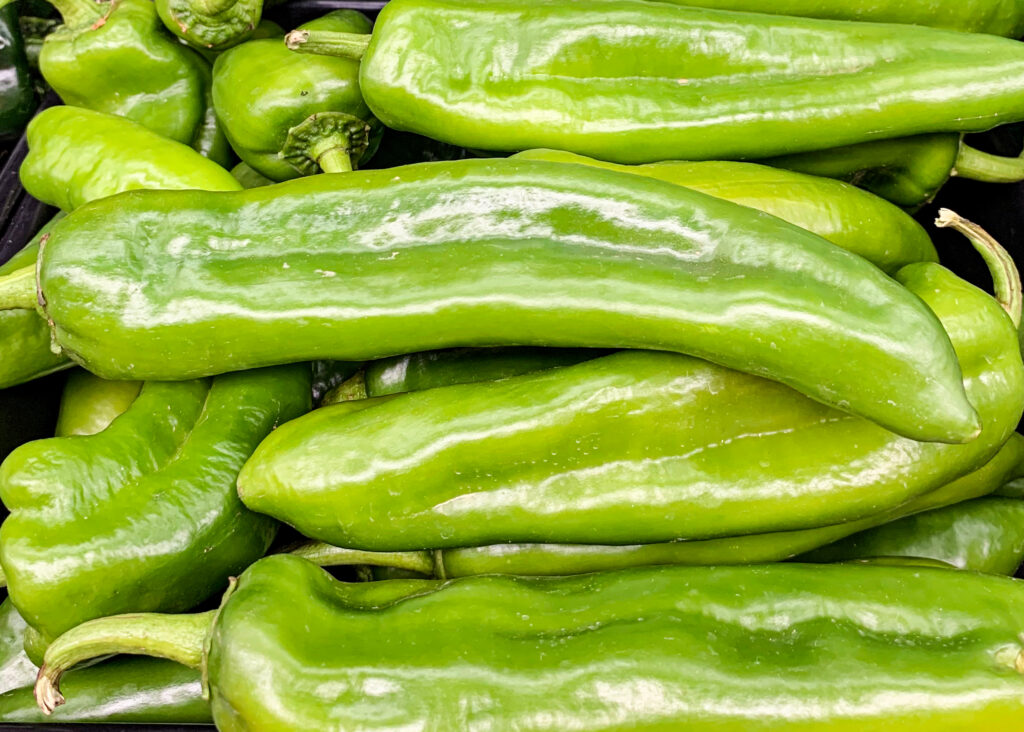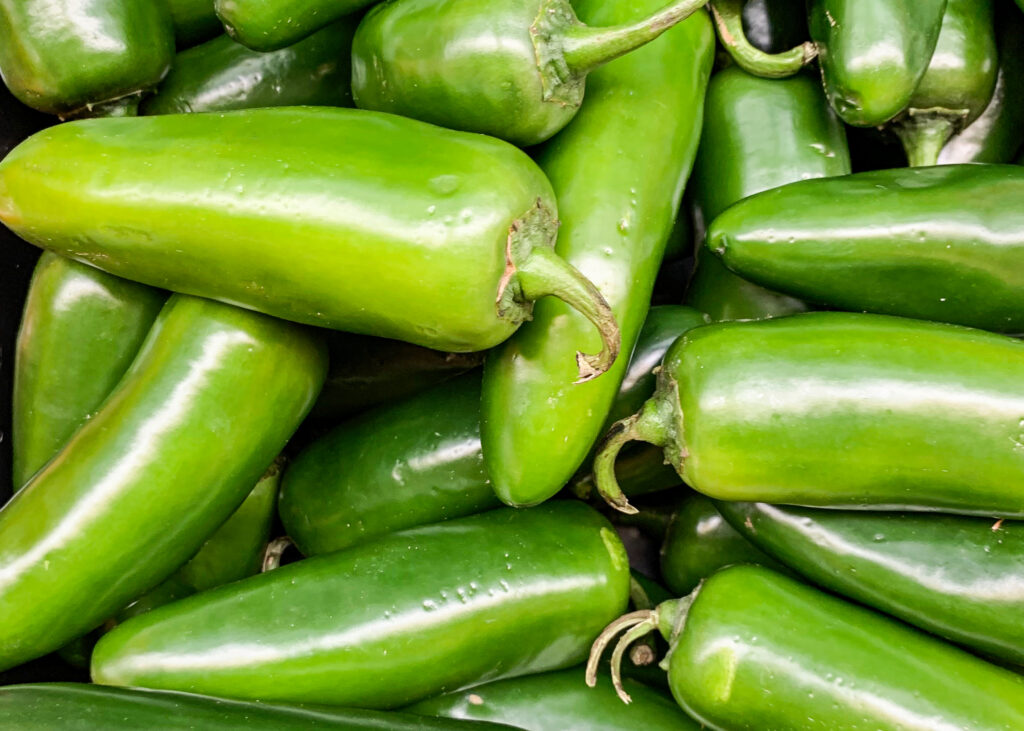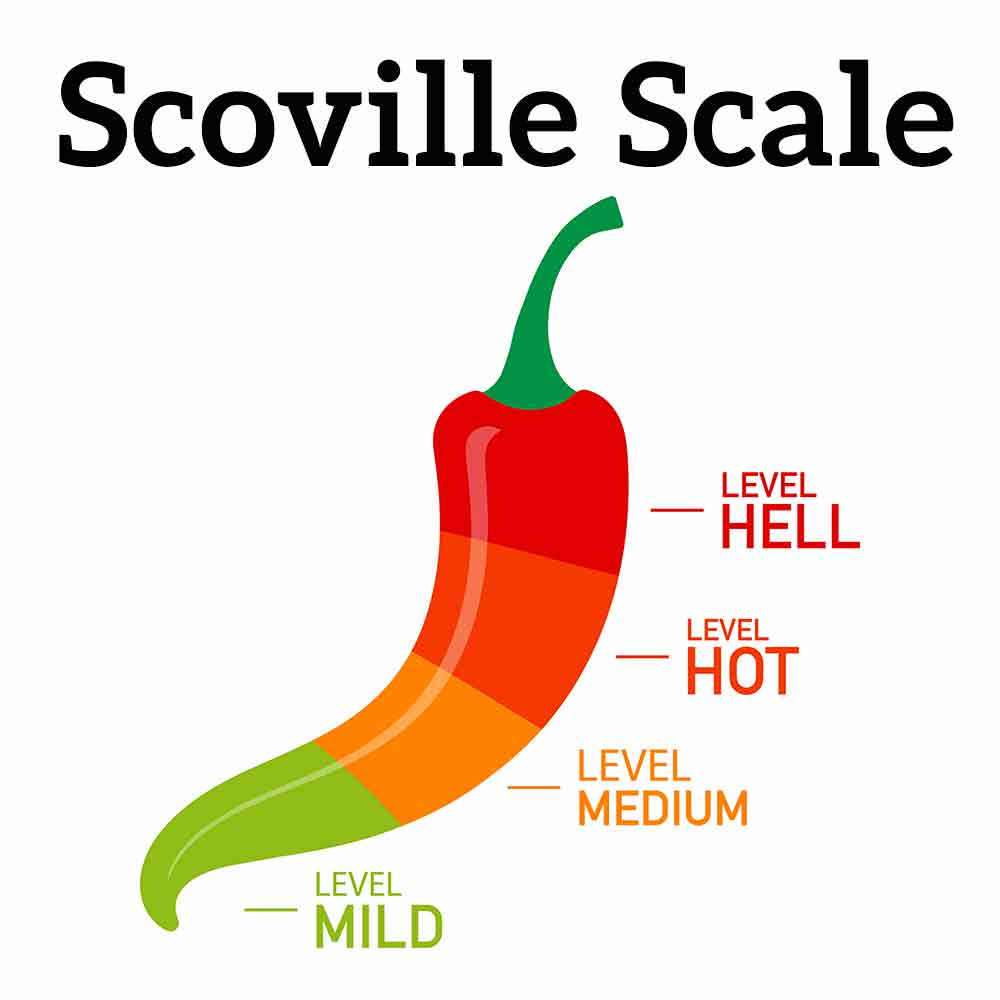





All about chile peppers—whether you crave or shy away from the spicy heat of chile peppers—they bring nuances and flavors far above how hot they are. Common flavors you can detect when eating chiles are sweet, smokey, earthy, bitter, peppery (as in black pepper), fruity, floral, grassy, bright, citrusy, and even more. As chiles become hotter it is harder to detect the secondary flavor nuances.
Even chiles of the same type can vary in heat level. When choosing fresh chiles, look for firm, well-formed peppers that are even in color. You can often exchange one chile variety for another when you know their characteristics and flavor profiles.
What is the Scoville Scale?

The Scoville Scale is the way to measure a chile pepper’s heat level. Named for Wilbur Scoville who developed the test in 1912 to rate heat units. Pure capsaicin (rated at 16,000,000 SHU) the molecule that makes chile peppers hot is assigned a number based on the dilutions needed to eradicate the burning heat. The higher the number, the hotter the chile pepper. Sweet bell peppers have no capsaicin so measure 0 on the Scoville Heat Scale.
Chile Pepper Primer
Depending on the time of year and the produce section of your grocery store or farmer’s market, the variety of peppers commonly available varies. You should always be able to find bell peppers and possibly even bags of assorted mini sweet peppers that give loads of color and a great crunch to dishes.
Specialized grocery stores may also have bags of Shishoto peppers that are often found on menus of Asian restaurants. Occasionally you may find long pale green-yellow Cuban peppers that are perfect for a quick saute and are found in many Italian dishes.
Anaheim Peppers

Anaheim peppers originally came from the region of the Southwest. It has a variety of names that fall under the umbrella of this versatile pepper. These long bright light green peppers are good to eat both raw and cooked. The flavor profile is fruity-sweet with a mild warmth. When you buy green chilies (either whole or diced) in small cans, you are enjoying Anaheim peppers. When green, these peppers add a tangy brightness. As they age and mature to red, the flavor picks up a slightly smoky note. The red chiles sweeten the longer they stay on the vine. When the red Anaheim peppers are dried, they are called New Mexico chilies, California chiles, or chili Colorado.
You can swap bell peppers with Anaheim peppers and vice versa. It is very kid friendly and perfect for people who don’t like any spice to their food. In comparison to jalapeño peppers, Anaheim peppers range from 16 times milder than jalapeños to just a bit less than the mildest jalapeño pepper.
Poblano Peppers

Poblano peppers are a great thick pepper, halfway between a bell pepper and a jalapeño. This popular pepper is used in many popular Mexican and Tex-Mex dishes. If you are looking for the perfect dish to try this pepper, try my recipe for Chile Rellenos. Dark green, shiny, and wedged shape, you can easily differentiate these peppers from the lighter green Anaheim peppers when compared side by side. Poblanos have a waxy outer skin that is often removed by roasting before use in other dishes.
When a poblano pepper ripens to red and is dried, these peppers are called ancho peppers. Green poblano peppers have a deep, rich earthy flavor profile with a bright peppery heat. As they age to red, the earthiness takes on a sweet smokiness. They range in comparison to jalapeños eight to two times milder. You can enjoy these peppers raw, but when you roast or grill poblanos, you can easily remove the outer skin and the thick flesh has a delicious crunch and the flavors deepen when lightly roasted.
Jalapeño Peppers

While many people consider the jalapeño spicy, when placed on the Scoville scale it falls slightly below moderate, but don’t dismiss all the wonderful dishes you can enjoy with these peppers. I think these peppers with their bright grassy notes are only accented with the kick of heat. Many cuisines use this pepper ranging from Tex-Mex to Thai to European cuisines. Look for firm smooth peppers that are uniform in color. You can always find bright green jalapeños, but if you ever come across peppers that are ripened to red the heat is often on the higher end of the scale as well as changing from bright grassy notes to more sweet floral notes.
You can reduce the heat from any pepper by removing the seeds and membrane before cooking with these marvelous chile peppers.
Fresno Peppers

These wonderful peppers look very similar to a jalapeño pepper, but they are slightly curved with a tapered point. While these peppers start as green and ripen to red, you will find the red version in the grocery store. The flavor profile is completely different from a jalapeño—they have complex sweet fruity notes with smokey heat. The pepper heralds from Fresno California and was cultivated in the 1950s. Fresno peppers are perfect to substitute with jalapeños or serranos. Use them in salsas, pickle them, use them in hot sauces, or simply slice them and enjoy them where you would fresh jalapeños.
Serrano Pepper

Serrano peppers are a bump up from jalapeños. They range from equal heat to nine times hotter. You can enjoy them raw sliced thinly in salads or other dishes or roasted and diced in hot sauces and salsas. While hot, they don’t weigh in at the same heat level as ground cayenne pepper found in your spice cupboard.
These thin slightly curved peppers are often found green in the grocery store which will have a grassy bright flavor profile with a moderate heat that comes on after a short delay. Fresh and fruity, whether green or red, the flavor slides to some floral sweetness as they ripen to red.
Habanero Peppers

These small wrinkled bites are a serious heat generator. The extra-hot heat pairs with a wonderful citrus flavor note and a hint of smoke and sweetness. You can find it raw, cooked in sauces, and even powdered as added to rubs for an extra kick of heat.
Don’t underestimate the power of the habanero, it weighs in around 76 times hotter than a jalapeño. Make sure you use gloves when handling this pepper. If you can handle the heat, habaneros and fruit pair wonderfully together.
Download this handy guide to learn all about chile peppers and how you can use them.





Leave a Reply